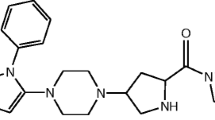Abstract
A rapid, precise and accurate gradient UPLC method was developed for the selective separation of degradation products of alcaftadine. Forced degradation studies of the drug were carried out by examining factors suggested by ICH guidelines. The degradation products were formed in acidic, alkaline and peroxide conditions; however, the drug was stable in neutral, thermal and photolytic degradation conditions. The chromatographic separation of the degradation products and the drug was carried out using an ACQUITY CSH C18 (100 × 2.1 mm, 1.7 µm) column and a mixture of ammonium acetate buffer (10 mM, pH 5.0) and methanol was used as mobile phase. The UPLC method was extended to UPLC–quadrupole time-of-flight tandem mass spectrometry for the characterization of the degradation products. Detection was achieved by PDA at 284 nm. The proposed method can be used in quality control for the determination of impurities of alcaftadine and for its stability studies. The developed method was validated in terms of specificity, linearity, accuracy, precision and robustness according to the ICH guidelines.
Graphical abstract




Similar content being viewed by others
References
Bohets H, McGowan C, Mannens G, Schroeder N, Edwards-Swanson K, Shapiro A (2011) Clinical pharmacology of alcaftadine, a novel antihistamine for the prevention of allergic conjunctivitis. J Ocul Pharmacol Ther 27(2):187–195
Greiner JV, Edwards-Swanson K, Ingerman A (2011) Evaluation of alcaftadine 0.25% ophthalmic solution in acute allergic conjunctivitis at 15 minutes and 16 hours after instillation versus placebo and olopatadine 0.1%. Clin Ophthalmol 5:87
Chemistry Review, http://www.accessdata.fda.gov/drugsatfda_docs/nda/2010/022134s000ChemR.pdf. Accessed 16 Mar 2015)
Mishra PR, Inamdar P, Jamdar P, Patel N, Rohit M, Satone D, Meshram DB (2015) Development and validation of UV-spectrophotometry and the first order derivative using the area under curve method for the estimation of alcaftadine in bulk and its ophthalmic dosage form. FS J Pharm Res 4(1):9–13
ICH guideline (1996) Q1B photostability testing of new drug substances and products, International Conference on Harmonisation, IFPMA, Geneva, Switzerland
ICH guideline (2003) Q1A (R2) Stability Testing of New Drug Substances and Products, International Conference on Harmonisation, IFPMA, Geneva, Switzerland
Singh S, Handa T, Narayanam M, Sahu A, Junwal M, Shah RP (2012) A critical review on the use of modern sophisticated hyphenated tools in the characterization of impurities and degradation products. J Pharm Biomed Anal 69:148–173
Talluri MVNK, Keshari KK, Kalariya PD, Srinivas R (2015) Selective separation and characterization of the stress degradation products of ondansetron hydrochloride by liquid chromatography with quadrupole time-of-flight mass spectrometry. J Sep Sci 38(10):1625–1632
Zhou N, Qian Q, Qi P, Zhao J, Wang C, Wang Q (2017) Identification of degradation products and process impurities from terbutaline sulfate by UHPLC–Q-TOF-MS/MS and in silico toxicity prediction. Chromatographia 80(5):793–804
Kalariya PD, Talluri MVNK, Ragampeta S (2014) Experimental design approach for selective separation of vilazodone HCl and its degradants by LC–PDA and characterization of major degradants by LC/QTOF–MS/MS. Chromatographia 19(77):1299–1313
Talluri MVNK, Dharavath S, Kalariya PD, Prasanth B, Srinivas R (2015) Structural characterization of alkaline and oxidative stressed degradation products of lurasidone using LC/ESI/QTOF/MS/MS. J Pharm Biomed Anal 105:1–9
Karen MA, Linda M, Baertschi SW (2003) Stress testing benchmarking study. Pharm Technol 27:60–72
Singh S, Junwal M, Modhe G, Tiwari H, Kurmi M, Parashar N, Sidduri P (2013) Forced degradation studies to assess the stability of drugs and products. Trends Anal Chem 49:71–88
Blessy M, Patel RD, Prajapati PN, Agrawal Y (2014) Development of forced degradation and stability indicating studies of drugs—a review. J Pharm Anal 4(3):159–165
Sridhar L, Karthikraj R, Murty M, Raju NP, Vairamani M, Prabhakar S (2013) Mass spectral analysis of N-oxides of nitrogen mustards, and N, N-dialkylaminoethyl-2-chlorides under electrospray ionization conditions. Int J Mass Spectrom 333:15–20
Holcapek M, Jirasko R, Lisa M (2010) Basic rules for the interpretation of atmospheric pressure ionization mass spectra of small molecules. J Chromatogr A 1217(25):3908–3921
International Conference on Harmonization, IFPMA (2005) Validation of analytical procedures: text and methodology. Q2 (R1), International Conference on Harmonization, IFPMA, Geneva, Switzerland
Lukulay P, Hokanson G (2005) Reconciling mass balance in forced degradation studies. Pharm Tech 29(10):106–112
Acknowledgements
The authors thank the Project Director, NIPER Hyderabad, and Director, IICT, Hyderabad, for their support. The authors are thankful to the Department of Pharmaceuticals, Minister of Chemicals and Fertilizers, Govt. of India, for providing research fellowships.
Author information
Authors and Affiliations
Corresponding author
Ethics declarations
Conflict of interest
The authors declare that there is no conflict of interest.
Ethical approval
This article does not contain any studies with human participants or animals performed by any of the authors.
Electronic supplementary material
Below is the link to the electronic supplementary material.
Rights and permissions
About this article
Cite this article
Chavan, B.B., Vijaya jyothi, P., Kalariya, P.D. et al. Alcaftadine: Selective Separation and Characterization of Degradation Products by LC–QTOF-MS/MS. Chromatographia 81, 631–638 (2018). https://doi.org/10.1007/s10337-018-3489-1
Received:
Revised:
Accepted:
Published:
Issue Date:
DOI: https://doi.org/10.1007/s10337-018-3489-1




